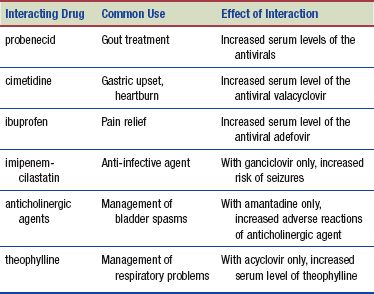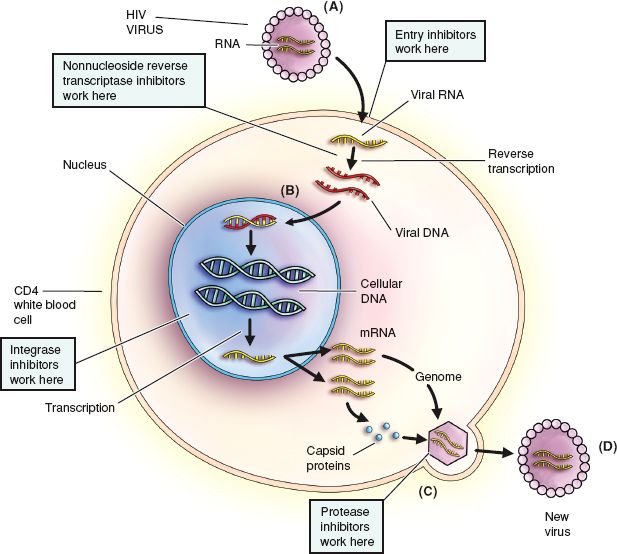DRUG CLASSES
Antivirals
Antiretrovirals
• Protease inhibitors
• Nucleoside/nucleotide reverse transcriptase inhibitors (NRTIs)
• Nonnucleoside reverse transcriptase inhibitors (NNRTIs)
• Entry inhibitors
• Integrase inhibitors
Compared with a fungus or bacterium, a virus is a very tiny infectious organism. A virus enters the body through various routes. It can be swallowed, inhaled, injected with a contaminated needle, or transmitted through the bite of an insect. To reproduce, the virus needs the cellular material of another living cell (the host cell). The virus attaches to a cell, enters it, and releases its DNA or RNA inside the cell. The viral material takes control of the cell and forces it to replicate the virus. The cell releases new viruses, which go on to infect other cells. The infected cell usually dies, because the virus keeps it from performing its normal functions.
More than 200 viruses have been identified as capable of producing disease. Common viral infections are those of the nose, throat, and respiratory system. An example is the common cold or influenza. A wart comes from a common virus that infects the skin. Other common viral infections are caused by the herpes viruses. Eight different herpes viruses infect people.
PHARMACOLOGY IN PRACTICE

Mr. Park, aged 77 years, lived alone at home. One day, as he was working in the garden, he fell. He lay in the garden with a fractured hip for about 2 hours before he was found. This event, compounded with other stressors of living alone, initiated an outbreak of herpes zoster (shingles). Consider this event as you read about medications that reduce the symptoms of viral disease.
Systemic viral infections occur when a virus attacks the nervous system (West Nile), liver (hepatitis C), or white blood cells (immunodeficiency diseases). The drugs used to treat viral infection are split into two categories: antiviral and antiretroviral agents. For a more complete listing, see the Summary Drug Table: Antiviral Drugs.
Systemic viral infections occur when a virus attacks the nervous system (West Nile), liver (hepatitis C), or white blood cells (immunodeficiency diseases). The drugs used to treat viral infection are split into two categories: antiviral and antiretroviral agents. For a more complete listing, see the Summary Drug Table: Antiviral Drugs.
ANTIVIRALS
Actions
Drugs that combat viral infections are called antiviral drugs. Antiviral drugs work by interfering with the virus’s ability to reproduce in a cell. Antiviral medications are limited in their ability to treat viral infections because viruses are tiny and replicate inside cells, changing how the cell works depending on the type of cell they invade. Antiviral drugs can be toxic to human cells, and viruses can develop resistance to antiviral drugs. These factors make antiviral drugs more difficult to develop. In comparison, a bacterial organism is relatively large and commonly reproduces outside of cells (e.g., in the bloodstream). Although antibiotics are not effective against viral infections, if a person has a bacterial infection in addition to a viral infection, an antibiotic is often needed.
Uses
Labeled Uses
Although infections caused by viruses are common, antiviral drugs have limited use because they are effective against only a small number of specific viral infections (Display 11.1). Antiviral drugs are used in the treatment or prevention of infections caused by:
• Cytomegalovirus (CMV) in transplant recipients
• Herpes simplex virus (HSV) 1 and 2 (genital) and herpes zoster
• Human immunodeficiency virus (HIV)
• Influenza A and B (respiratory tract illness)
• Respiratory syncytial virus (RSV; severe lower respiratory tract infection primarily affecting children)
• Hepatitis B and C
Unlabeled Uses
Because there are a limited number of antiviral drugs and more than 200 viral diseases, the primary health care provider may decide to prescribe an antiviral drug for an unlabeled use even though its effectiveness for that use is not documented. Approval by the U.S. Food and Drug Administration (FDA) is necessary for a drug to be prescribed. On occasion, the use of a drug for a specific disorder or condition may be under investigation, or it may be approved for use in another country. In this instance, the drug may be prescribed by the primary health care provider for the condition under investigation. The use of the drug for a specific disorder or condition that is not officially approved by the FDA is called an unlabeled use. Examples of unlabeled uses of the antiviral drugs include treatment of CMV and HSV infections after transplantation procedures and varicella pneumonia; the treatment of CMV retinitis in immunocompromised patients; and the use of ribavirin (in aerosol form) for influenza A and B, acute and chronic hepatitis, herpes genitalis, and measles (in oral form).
Adverse Reactions
Gastrointestinal System Reactions
• Nausea, vomiting
• Diarrhea
Other Reactions
• Headache
• Rash
• Fever
• Insomnia
Contraindications
Do not administer antivirals if the patient has a history of allergies to the drug or other antivirals. Cidofovir (Vistide) should not be given to patients who have renal impairment or in combination with medications that are nephrotoxic, such as aminoglycosides. Ribavirin should not be used in patients with unstable cardiac disease. These drugs should be used during pregnancy (pregnancy categories B and C) and lactation only when the benefit outweighs the risk to the fetus or child (ribavirin is a pregnancy category X).
Precautions
Antivirals should be used cautiously in patients with renal impairment, low blood cell counts, history of epilepsy (rimantadine), and history of respiratory disease (zanamivir).
Interactions
The following interactions may occur when an antiviral is administered with another agent:

Display 11.1 Description of Viral Infections
Cytomegalovirus (CMV)
CMV, a virus of the herpes family, is a common viral infection. Healthy individuals may become infected yet have no symptoms. However, immunocompromised patients (such as those with HIV or cancer) may have the infection. Symptoms include malaise, fever, pneumonia, and superinfection. Infants may acquire the virus from the mother while in the uterus, resulting in learning disabilities and mental retardation. CMV can infect the eye, causing retinitis. Symptoms of CMV retinitis are blurred vision and decreased visual acuity. Visual impairment is irreversible and can lead to blindness if untreated.
Genital human Papillomavirus (HPV)
HPV is the most common sexually transmitted infection (STI). There are over 40 different HPV types that infect the genitals, mouth, and throat. However, symptoms can be minor enough that most people do not even know they are infected. HPV infection can lead to genital warts, cervical cancer, and rare forms of throat warts or cancers. Warts can appear weeks to months after contact with an infected partner. Cervical symptoms do not appear until late in the disease. Treatment includes removal of warts, yet HPV is best treated by prevention with vaccine (see Chapter 49).
Hepatitis B (HBV) and C (HCV) virus
Hepatitis is an inflammation of the liver. HBV is spread by infected blood or body fluids. Sexual contact is the most frequent mode of transmission, followed by use of contaminated needles. Symptoms of infection include fever and joint pains. Acute HBV typically resolves; chronic HBV is treated to boost the immune system. HCV is related to the yellow fever virus and is primarily spread by exposure to infected blood. Most people show no signs or symptoms of HCV until the infection becomes chronic and lab results show persistent liver inflammation. Treatment is offered to reduce the chance of cirrhosis (final stages of liver disease). Late-stage cirrhosis due to HCV is currently the primary reason for liver transplant.
Herpes Simplex Virus (HSV)
HSV is divided into HSV-1, which causes oral, ocular, or facial infections, and HSV-2, which causes genital infection. However, either type can cause disease at either body site. HSV-1 causes painful vesicular lesions in the oral mucosa, on the face, or around the eyes. HSV-2 or genital herpes is usually transmitted by sexual contact and causes painful vesicular lesions on the mucous membranes of the genitalia. Vaginal lesions may appear as mucous patches with grayish ulcerations. The patient may appear irritable, lethargic, and jaundiced and may have difficulty breathing or experience seizures. The lesions usually heal within 2 weeks. Immunosuppressed patients may develop a severe systemic disease.
Herpes Zoster Virus (HZV)
Herpes zoster (shingles) is caused by the varicella (chickenpox) virus. It is highly contagious. The virus causes chickenpox in the child and is easily spread via the respiratory system. Recovery from childhood chickenpox results in the infection lying dormant in the nerve cells. The virus may become reactivated later in life as the older adult’s immune system weakens or the individual becomes ill with other disorders. The lesions of herpes zoster appear as pustules along a sensory nerve route. Pain often continues for several months after the lesions have healed.
Human Immunodeficiency Virus (HIV)
HIV or AIDS is a type of viral infection transmitted through an infected person’s bodily secretions, such as blood or semen. HIV destroys the immune system, causing the body to develop opportunistic infections such as Kaposi’s sarcoma, Pneumocystis carinii pneumonia, or tuberculosis. Symptoms include chills and fever, night sweats, dry productive cough, dyspnea, lethargy, malaise, fatigue, weight loss, and diarrhea.
Influenza (flu)
Influenza, commonly called the “flu,” is an acute respiratory illness caused by influenza viruses A and B. Symptoms include fever, cough, sore throat, runny or stuffy nose, headache, muscle aches, and extreme fatigue. Most people recover within 1 to 2 weeks. Influenza may cause severe complications such as pneumonia in children, the elderly, and other vulnerable groups. The viruses causing influenza continually change over time, which enables them to evade the immune system of the host. These rapid changes in the most commonly circulating types of influenza virus necessitate annual changes in the composition of the flu vaccine.
Respiratory Syncytial Virus (RSV)
RSV infection is highly contagious and affects mostly children, causing bronchiolitis and pneumonia. Infants younger than 6 months are the most severely affected. In adults, RSV causes colds and bronchitis, with fever, cough, and nasal congestion. When RSV affects immunocompromised patients, the consequences can be severe and sometimes fatal.
ANTIRETROVIRALS
Actions
HIV is called a retrovirus. When left untreated this viral infection can progress to acquired immunodeficiency syndrome (AIDS). Retroviruses attack the host cell just like a virus; the difference is that RNA is the primary component of the virus instead of DNA. Retroviruses also contain an enzyme called reverse transcriptase that is used to turn the RNA of the virus into DNA, helping to reproduce more of the virus. To control the disease effectively, a number of drugs are used that work at different portions of the life cycle of the virus. Figure 11.1 illustrates how HIV replicates in a human cell and where the antiretroviral drugs act. Using multiple antiretroviral drugs in therapy is called highly active antiretroviral therapy (HAART). The first three categories of the following types of drugs are used in HAART (for more information see the Summary Drug Table: Antiviral Drugs):
• Protease inhibitors, which block the protease enzyme so the new viral particles cannot mature
• Reverse transcriptase inhibitors, which block the reverse transcriptase enzyme so the HIV material cannot change into DNA in the new cell, preventing new HIV copies from being created
• Nonnucleoside reverse transcriptase inhibitors, which latch on to the reverse transcriptase molecule to block the ability to make viral DNA
• Entry inhibitors, which prevent the attachment or fusion of HIV to a host cell for initial entry
• Integrase inhibitors, which prevent enzymes from inserting HIV genetic material into the cell’s DNA
Uses
Antiretroviral drugs are used in the treatment of HIV infection and AIDS.

Figure 11.1 Example of viral infection—HIV replication and drug targeting. (A) HIV enters a CD4 cell, sheds its protective coating, and inserts its genetic material into the cell. (B) HIV DNA enters the nucleus of the CD4 cell and transmits instructions to duplicate HIV DNA. (C) The viral RNA and viral proteins assemble at the cell membrane into a new virus. (D) The newly assembled HIV leaves the cell to infect other CD4 cells.
Stay updated, free articles. Join our Telegram channel

Full access? Get Clinical Tree


